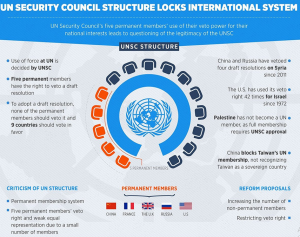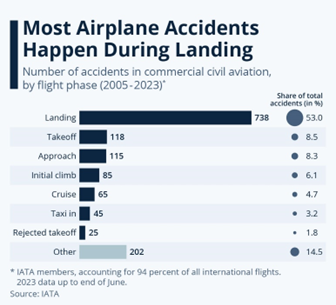THE INDIAN POLITY AND GOVERNANCE
1. THE DELHI SPECIAL POLICE ESTABLISHMENT (AMENDMENT) BILL, 2021
THE CONTEXT: The Rajya Sabha passed the Delhi Special Police Establishment (Amendment) Bill, 2021 which seeks to amend the Delhi Special Police Establishment Act, 1946, and the Central Vigilance Commission (Amendment) Bill, 2021. It replaces the Delhi Special Police Establishment (Amendment) Ordinance, 2021.
THE EXPLANATION:
The Central Vigilance Commission (Amendment) Bill, 2021, passed in Lok Sabha in early December 2021. It seeks to extend the tenure of the director of the Enforcement Directorate to a maximum of five years. And also, the bill extends the tenure of the Director of the Central Bureau of Investigation (CBI) to a maximum of five years from the present two years, is a move by the Central Government to check corruption and to ensure and enhance transparency.
According to the Government, the nation is faced with the triple menace of corruption, black money and international crime that is linked to drug trafficking, terrorism and criminal offences and all these are a threat to the security and financial structure of the country.
BACKGROUND:
Delhi Special Police Establishment Act was passed in 1946. CBI derives its powers from the Delhi Special Police Establishment Act, 1946. It was established in 1941 as the Special Police Establishment, entrusted with domestic security. Later, the Santhanam Committee on Prevention of Corruption recommended the establishment of the CBI. It is the main investigating agency of the GOI.
The CBI figures in the Union List of the Seventh Schedule of the constitution of India. Sl. No. 8 of this List reads: “Central Bureau of Intelligence and Investigation.”
About the CBI Director and his appointment:
- The Director of the CBI is appointed as per section 4A of the Delhi Special Police Establishment Act of 1946.
- The Director is appointed by the central government on the recommendation of a Committee consisting of the: (i) Prime Minister (Chairperson), (ii) Leader of Opposition in Lok Sabha, and (iii) Chief Justice of India (CJI) or a judge of the Supreme Court nominated by the CJI. Under the Act, the Director has a tenure of minimum two years (Now it is 5 years).
About Enforcement Directorate:
- The origin of this Directorate goes back to 1st May 1956, when an ‘Enforcement Unit’ was formed, in the Department of Economic Affairs, for handling Exchange Control Laws violations under Foreign Exchange Regulation Act, 1947 (FERA ’47).
- In the year 1957, this Unit was renamed as ‘Enforcement Directorate’.
- Presently, it is part of the Department of Revenue, Ministry of Finance.
- The Organization is mandated with the task of enforcing the provisions of two special fiscal laws – Foreign Exchange Management Act, 1999 (FEMA) and Prevention of Money Laundering Act, 2002 (PMLA).
Composition: Besides directly recruiting personnel, the Directorate also draws officers from different Investigating Agencies, viz., Customs & Central Excise, Income Tax, Police, etc. on deputation. Now the tenure of the director of the Enforcement Directorate is up to a maximum of 5 years.
THE INTERNATIONAL RELATIONS
2. INDIA VOTES AGAINST UN DRAFT RESOLUTION ON CLIMATE CHANGE
THE CONTEXT: India voted against a draft resolution at the United Nations Security Council (UNSC) linking climate to security, saying it was an attempt to shift climate talks from the United Nations Framework Convention on Climate Change (UNFCCC) to the Security Council and a “step backward” for collective action on the issue.
THE EXPLANATION:
India was the only other country in the 15-member group to vote against the move. One of the objectives of the debate was to examine how terrorism and security risks could be linked to climate change, as per a concept note circulated by Niger.
What was the proposal?
- The proposal of the draft resolution was tabled during the debate titled ‘Maintenance of International Peace and Security: Security in the Context of Terrorism and Climate Change.’ The debate sought to understand how security risks would evolve over the coming decades as a result of climate change.
- Climate change often leads to food and water shortages, loss of land or livelihoods, or migration. All these factors contribute to increasing global instability and insecurity, which the supporters of the draft said were pertinent matters for the UNSC to discuss.
- The draft resolution would have created the framework and space necessary for the UNSC to discuss matters of climate change as well. The resolution was sponsored by Niger and Ireland, the former also holding the presidency of the UNSC for the month of December.
Undermining progress
- The draft resolution, according to India would undermine progress made at Glasgow, where the latest round of talks under the UNFCCC, the 26th Conference of the Parties (COP26), concluded in November 2021.
- According to India, the developing and ‘least developed’ countries had worked, over the last two decades, to make “common but differentiated” responsibilities a fundamental tenet of climate action,
- Also, it noted, that this attempt is to link climate with security really seeks to obfuscate the lack of progress on critical issues under the UNFCCC process.
About UNSC:
- Established in 1945, the United Nations Security Council (UNSC) is one of the five principal organs of the United Nations, charged with the maintenance of international peace and security as well as accepting new members to the United Nations and approving any changes to UN Charter.
- Its powers include the establishment of peacekeeping operations, the establishment of international sanctions, and the authorization of military action through Security Council resolutions; it is the only UN body with the authority to issue binding resolutions to member states.
THE ENVIRONMENT AND ECOLOGY
2. CLIMATE SMART CITIES ASSESSMENT FRAMEWORK
THE CONTEXT: The Centre used a competitive process to select 100 cities for upgradation with significant investments through the Smart Cities Mission (SCM) launched on June 25, 2015.
THE EXPLANATION:
THE STATUS OF THE SMART CITIES MISSION:
- In September 2020, the Ministry of Housing and Urban Affairs (MoHUA) expanded the emphasis on climate-friendly infrastructure in smart cities through the Climate Smart Cities Assessment Framework 2.0 and a “Streets for People” plan that would put pedestrians and non-motorised road users at the centre of urban planning.
- Yet, many plans under the SCM, which is funded partly by the Centre, remain incomplete due to the COVID-19 pandemic that stalled activities for most of 2020. In response, the Smart Cities Mission has extended the implementation date and given cities until June 2023 to complete the work.
|
Smart City Mission
|
How far have smart cities progressed?
The Urban Affairs Ministry says that as of November 12, 2021, a total of 6,452 projects at a cost of ₹1,84,998 crore had been tendered. In terms of work progress, 5,809 projects worth ₹1,56,571 crore were under implementation or had been completed, it says, although it is not clear how many were completed.
Image Courtesy: Smart city mission, GOI

What challenges are faced by smart city plans?
- The key features of smart cities, according to the Ministry, are liveability, economic ability and sustainability. These broad ideas have a universal character and incorporate access to clean water, safe streets and public spaces, good public transport, facilities for health and education and places for recreation. They also seek to expand economic opportunity for all and address environmental stresses – rising temperatures, extreme weather events, bad air quality, flood and drought, and lost urban biodiversity.
- A core factor of liveability and inclusivity, such as affordable rental housing, determines the usability of other features of a smart city.
- Some centres, such as Ahmedabad, Bhopal, Bhubaneshwar, Indore, and Thane have pencilled in housing developments of various models, ranging from slum improvement to free sale of houses, into their smart city projects, a few involving over ₹1,000 crores; others have smaller levels of outlays for housing.
- Ongoing smart city plans also face the pressure of designing for climate change. The Climate Smart Assessment Framework would need to put in compulsory features to align all investments with national commitments towards obligations under the Paris Agreement of the UN Framework Convention on Climate Change (UNFCCC) and UN Sustainable Development Goals (SDG).
THE INDIAN ECONOMY
4. WHOLESALE INFLATION RISES
THE CONTEXT: Wholesale inflation, based on the Wholesale Price Index, jumped to 14.23 per cent in November from 12.54 per cent in October 2021 (on a year-on-year basis), primarily due to a rise in food prices especially of vegetables, and minerals and petroleum products, data released by the Ministry of Commerce & Industry.
THE EXPLANATION:
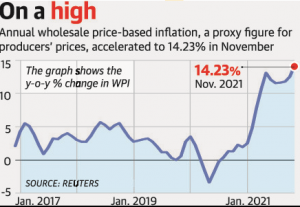
- Fuel and power prices rose 81 per cent versus 37.18 per cent in October, while manufactured product prices rose 11.92 per cent, against 12.04 per cent in the prior month.
- Inflation rates at both wholesale and retail levels are showing a rising trend. The WPI grew 12.54 per cent during October, while the WPI for September was revised to 11.80 per cent from 10.66 per cent. The WPI inflation rate in November 2020 was at 2.29 per cent. The retail inflation print for October was at 4.48 per cent and 6.93 per cent in November 2020. It is, however, within the 4+/-2 per cent targeted range of the Reserve Bank of India.
Factors behind the uptick
- High food, fuel and commodity prices along with supply-side bottlenecks are reflected in the inflation rates at both retail and wholesale level. A sharp surge in primary articles inflation which doubled to 10.34 per cent in November 2021 from 5.20 per cent in October 2021 was mainly responsible for taking the wholesale inflation to record levels.
- Within primary articles, food articles inflation jumped to 4.88 per cent in November from a negative 1.69 per cent a month ago. At the retail level, food inflation increased to 1.87 per cent in November from 0.85 per cent in October 2021.
- Core inflation — the non-food, non-fuel inflation component — jumped to a five-month high of 6.08 per cent at the retail level in November. At the wholesale level, it climbed to a fresh high of 12.3 per cent in November 2021.
Value Addition:
- Inflation is the rate at which the value of a currency is falling and, consequently, the general level of prices for goods and services is rising.
- Inflation is sometimes classified into three types: Demand-Pull inflation, Cost-Push inflation, and Built-In inflation.
- The most commonly used inflation indexes are the Consumer Price Index (CPI) and the Wholesale Price Index (WPI).
- The core inflation rate is the price change of goods and services minus food and energy. Food and energy products are too volatile to be included.
- As per RBI, an inflation target of 4 per cent with a +/-2 per cent tolerance band, is appropriate for the next five years (2021-2025).
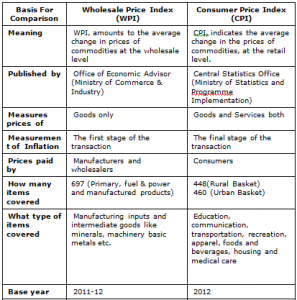
5. ADB GROWTH UPDATE
THE CONTEXT: The Manila-based lender now sees 2021 gross domestic product (GDP) growth of 7.0% for developing Asia, down from 7.1%, and 2022 growth of 5.3%, down from 5.4% in September 2021.
THE EXPLANATION:
- “COVID-19 has receded in developing Asia but rising infections worldwide and the emergence of a fast-spreading variant suggests that the pandemic will take time to play out,” the ADB said in a supplement to its Asian Development Outlook report.
- Most of developing Asia’s subregions are forecast to grow slower than previously thought this year, due in part to weak recovery in China.
- China’s economy, which staged an impressive rebound from last year’s pandemic slump, has lost momentum in recent months as it grapples with surging prices, a slowing manufacturing sector, debt problems in the property market and persistent COVID-19 outbreaks.
- The ADB projects China’s economy will grow 8.0% this year, slightly weaker than its 8.1% estimate in September, before it slows to 5.3% in 2022, down from its earlier projection of 5.5%.
For India:
- “India, South Asia’s largest economy, is now expected to grow 9.7% in fiscal year (FY) 2021, which ends 31 March 2022.
- The reduction of 0.3 percentage points comes amid supply chain issues that are affecting the industry. India’s outlook for FY2022 is maintained at 7.5%, as domestic demand is expected to normalize.
About ADB:
- It is a regional development bank, established on 19 December 1966.
- It’s headquartered at Manila, Philippines.
- ADB is an official United Nations Observer.
Who can be its members?
- The bank admits the members of the United Nations Economic and Social Commission for Asia and the Pacific (UNESCAP, formerly the Economic Commission for Asia and the Far East or ECAFE) and non-regional developed countries.
- ADB now has 68 members, 49 from within Asia.
Voting rights:
- It is modelled closely on the World Bank and has a similar weighted voting system where votes are distributed in proportion with members’ capital subscriptions.
- As of 31 December 2019, ADB’s five largest shareholders are Japan and the United States (each with 15.6% of total shares), the People’s Republic of China (6.4%), India (6.3%), and Australia (5.8%).
Roles and functions:
- Dedicated to reducing poverty in Asia and the Pacific through inclusive economic growth, environmentally sustainable growth, and regional integration.
- This is carried out through investments – in the form of loans, grants and information sharing – in infrastructure, health care services, financial and public administration systems, helping nations prepare for the impact of climate change or better manage their natural resources, as well as other areas.
THE INTERNAL SECURITY
6. BORDER DISPUTES WITHIN STATES
THE CONTEXT: According to the Ministry of Home Affairs, 11 States and one Union Territory have boundary disputes between them. It added that “occasional protests and incidents of violence are reported from some of the disputed border areas”.
THE EXPLANATION:
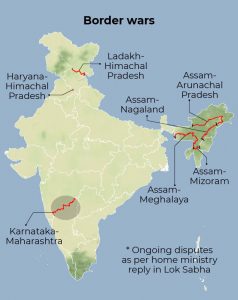
“There are boundary disputes arising out of demarcation of boundaries and claims and counter-claims over territories between Andhra Pradesh-Odisha, Haryana-Himachal Pradesh, Union Territories of Ladakh-Himachal Pradesh, Maharashtra-Karnataka, Assam-Arunachal Pradesh, Assam-Nagaland, Assam-Meghalaya, Assam-Mizoram”.
Assam-Mizoram:
Mizoram borders Assam’s Barak Valley, and both border Bangladesh. The boundary between the two states, which runs 165 km today, has a history dating back to the time when Mizoram was a district of Assam and known as Lushai Hills. Boundary demarcations in 1875 and 1933, particularly the second one, are at the heart of the dispute.
The 1875 demarcation, notified on August 20 that year, derived from the Bengal Eastern Frontier Regulation (BEFR) Act, 1873. It differentiated Lushai Hills from the plains of Cachar in Assam’s Barak Valley. This was done in consultation with Mizo chiefs, and it became the basis for the Inner Line Reserve Forest demarcation in the Gazette.
Assam-Arunachal Pradesh
The boundary issue between Assam and Arunachal is as ancient as the reign of the Ahom Kings who ruled Assam till the British annexed Assam in 1826. Encroachments by residents across the 804-km border that Assam shares with Arunachal Pradesh have led to rising tensions occasionally. A suit has been pending in Supreme Court since 1989 on the issue. Border Roads Organisation has marked Kim in Arunachal Pradesh as part of Assam by mistake.
Assam-Nagaland
Assam and Nagaland share a 434-km border and the disputes relate to 66000 Sq Km of land mostly along the Sivasagar district of Assam. The two states have been disputing their shared border ever since Nagaland was carved out of Assam’s Naga Hills district. While Assam wants the status quo and sticks to the border decision taken on December 1, 1963, Nagaland demands all Naga territories be transferred to the state. Claiming that all Naga territories belong to them, Nagaland wants restoration of land-based on a 16-point agreement of 1960, which led to the creation of the state.
Assam-Meghalaya
Meghalaya shares its internal border only with Assam and there are disputes along the 733 km border at 12 places. The border row between both States started with the formation of states under the North-Eastern Areas (Reorganisation) Act, 1971. As per the Act, Blocks I and II of the Mikir Hills—presently, the Karbi Anglong district—were granted to Assam. Meghalaya claims that both these blocks were part of the erstwhile United Khasi and Jaintia Hills when it was created in 1835.
Himachal Pradesh-Haryana
Himachal Pradesh has an inter-state boundary dispute at Parwanoo with Haryana. Haryana also claims that a large area of the land bordering Himachal in Parwanoo belongs to them and has asked the Survey of India to demarcate the land. Haryana blames that Himachal does not accept joint forest demarcations. A Survey of India had recently reported that Himachal Pradesh encroached upon some land at Parwanoo that belongs to Haryana.
Ladakh-Himachal Pradesh
Sarchu, situated at an elevation of 4,290 metres on the Leh-Manali highway, is a disputed territory between Ladakh and Himachal Pradesh.
Maharashtra-Karnataka
Maharashtra is claiming Marathi-speaking regions consisting of more than 800 villages of Belgaum, Karwar and Nippani that were included in Karnataka. Belgaum district in Karnataka, which has both Kannada and Marathi speakers, was added to Karnataka in 1956 when states were reorganised on a linguistic basis. As part of the Bombay Presidency in British India, Belgaum was under Bombay state. Karnataka says that some of its Kannada-majority villages had been included in Maharashtra.
Andhra Pradesh and Odisha
The border dispute between Andhra Pradesh and Odisha over the contentious Kotia Gram Panchayat in the Koraput district. The Kotia Gram Panchayat has 28 revenue villages; Odisha mistakenly did not survey 21 villages during its formation in 1936. At the time of the creation of Andhra Pradesh in the year 1955, those 21 villages were also not surveyed by Andhra resulting in a perpetual dispute over these bordering villages.
THE PRELIM PRACTICE QUESTION
Q1. Consider the following statements about the Wholesale Price Index (WPI):
- It measures inflation at the first stage of the transaction.
- It is compiled by the Office of Economic Advisor in the Ministry of Commerce & Industry.
- It measures inflation on a month-on-month basis.
Which of the statements given above is/are incorrect?
a) 1 and 2 only b) 2 and 3 only
c) 3 only d) 1 and 3 only
ANSWER FOR 14TH DECEMBER 2021 PRELIMS PRACTICE QUESTIONS
Answer: D
Explanation:
- CPI for Industrial Workers (IW): Compiled by the Labour Bureau in the Ministry of Labour and Employment.
- CPI for Agricultural Labourer (AL): Compiled by the Labour Bureau in the Ministry of Labour and Employment.
- CPI for Rural Labourer (RL): Compiled by the Labour Bureau in the Ministry of Labour and Employment.
- CPI (Rural/Urban/Combined): Compiled by the Central Statistical Organisation (CSO) in the Ministry of Statistics and Programme Implementation.

